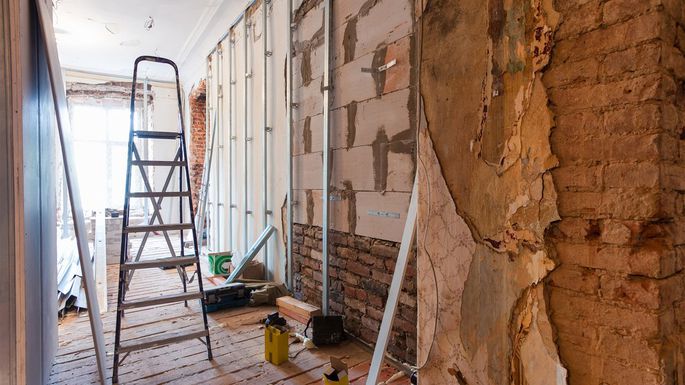While searching for my first home last year, I fell in love with one just outside Baton Rouge, LA. It had everything—a yard robust with trees, calmness, and proximity to all my favorite stores.
But there was a catch: The year before, the entire area had been severely flooded—and everything on the market was remodeled, including my dream home.
What’s wrong with that, you ask? Well, outside of watching “This Old House” marathons as a kid, I had no idea how to judge whether those full remodels were just sloppy rush jobs.
And I’m here to tell you: Distinguishing a solid remodel from a poor one is harder than it looks. Your real estate agent can help. Your home inspector can find flaws in major systems like the electrical or the roofing. But making the final decision on the remodel is up to you—and it can be tricky.
That said, after nearly a year of living in my house, I (mostly) love it. But I’ve noticed some small mistakes that drive me a bit crazy.
To help you avoid the same fate, we asked the pros for their best tips. Before you put down an offer, look for these telltale signs.
1. The major systems are in working order
Whether you’re looking for your first home or you’re a seasoned pro, it’s easy to get dazzled by brand-new finishes, flooring, and the smell of new paint.
But take heed: “Sometimes buyers get distracted by the ‘new’ factor and forget about the everyday use factor,” says Darbi McGlone, Realtor®.
McGlone says if she’s buying a remodel for herself, she makes sure these three things are in good condition: “Heat and AC, windows, and roof.”
2. The kitchen isn’t disappointing
From daily use to eventual resale, having a great kitchen is key. But kitchens are expensive to remodel—and if the job was DIY, there’s a strong chance that corners were cut.
To make sure you’re getting a good deal, start by examining the cabinetry.
“I’ve seen homes where they only replaced the bottom cabinets and not the top to match,” McGlone says.
Check the wood quality and finish on both the top and bottom of the cabinets. Test the drawers. And make sure the countertop rests firmly against the back wall.
From there, check the backsplash.
“Backsplash tiles that aren’t evenly spaced are due to poor installation—and a big giveaway that the whole job might not have been well-done,” says Peter Sommer, a broker with TripleMint, in New York City.
Finally, take a good look at the appliances. If you’re viewing a full kitchen remodel that seems to have pulled out the stops on high-end finishes, the appliances should match.
If they don’t, McGlone says, it might be a sign that the whole remodel was designed to look good during a walk-through, not necessarily to hold up over time.
“If you see they’ve cut corners on little things like appliances … run,” she urges.
3. Attention was paid to details in the bathroom
It’s easy for bathrooms to look good at first glance, even if the remodel job was subpar. (I lived in my house for five months before I realized the guest bathroom shower tiles weren’t level.)
To make sure you’re getting the best bathroom possible, examine the tiny details.
First, “check to see if all the plumbing fixtures are the same make and model,” suggests Michael Bill, chief operating officer for VAPR Construction, in Northern Virginia. A mismatch could signal that the contractor bought the cheapest available on the market, he says.
Then, get down and look at the hidden hardware. According to Bill, the shut-off valves, supply lines, and P-traps should generally be replaced during a major remodel. The trim rings around those hardware pieces should be replaced as well.
“These are corners typically cut on cheap and quick remodels,” he says.
4. The floors are even
Flooring is one of the easiest things to screw up and one of the most annoying things to live with if it’s done wrong—since it will literally be there with every step you take.
Hardwood can buckle or warp if installed incorrectly. Laminate laid wrong can create a fun-house effect, where it seems like the floors are moving up and down when you walk on them. (I saw not one, but two houses like this.)
And then there are those pesky porcelain wood-look tiles. They’re extremely popular because they’re durable and, when done right, look great. But they’re also notoriously hard to install.
“It takes a true professional to install,” McGlone says. “Check those floors—they will be very uneven if it was a DIY job.”
(Pro tip: Scooting slowly across the floor will help you catch any corner lifts, a clear sign a tile job wasn’t done correctly.)
5. The finishes are pristine
“Better attention to detail on the finishes is typically a good indicator on how much the contractor cared about the project as a whole,” Bill says.
Start by examining the doors, which are easy to overlook when every room is open for the walk-through, recommends Matthew Breyer, president and lead designer of Breyer Construction & Landscape in Reading, PA.
“I look at how doors close—if they latch tightly and if the ‘reveal,’ the small gap around the edges of a closed door, is consistent,” he explains. “Doors that don’t line up or close properly hint at the potential for other quality control issues in the house.”
From there, make sure molding lines up on the corners, frames seem level and even, and stair railings are snug and secure.
“Ask yourself: Did the contractor dust off woodwork before painting or can you feel the dust painted over?” Bill suggests. If you can feel dust, there’s a good chance other issues were overlooked.
Finally, get the house blessed by your real estate agent before you make an offer. Agents have seen countless remodeling jobs—from complete DIYs to the most professional jobs. So don’t be shy!
Original article found at: https://www.realtor.com/advice/buy/buying-remodeled-home-good-deal-or-bad/

